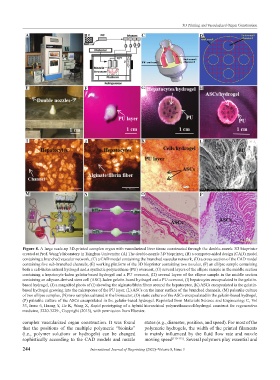Page 252 - IJB-8-3
P. 252
3D Printing and Vascularized Organ Construction
A B C D
E F G H
I J K L
M N O P
Figure 8. A large scale-up 3D-printed complex organ with vascularized liver tissue constructed through the double-nozzle 3D bioprinter
created at Prof. Wang’s laboratory in Tsinghua University: (A) The double-nozzle 3D bioprinter, (B) a computer-aided design (CAD) model
containing a branched vascular network, (C) a CAD model containing the branched vascular network, (D) a cross-section of the CAD model
containing five sub-branched channels, (E) working platform of the 3D bioprinter containing two nozzles, (F) an ellipse sample containing
both a cell-laden natural hydrogel and a synthetic polyurethane (PU) overcoat, (G) several layers of the ellipse sample in the middle section
containing a hepatocyte-laden gelatin-based hydrogel and a PU overcoat, (H) several layers of the ellipse sample in the middle section
containing an adipose-derived stem cell (ASC)-laden gelatin-based hydrogel and a PU overcoat, (I) hepatocytes encapsulated in the gelatin-
based hydrogel, (J) a magnified photo of (I) showing the alginate/fibrin fibers around the hepatocytes, (K) ASCs encapsulated in the gelatin-
based hydrogel growing into the micropores of the PU layer, (L) ASCs on the inner surface of the branched channels, (M) pulsatile culture
of two ellipse samples, (N) two samples cultured in the bioreactor, (O) static culture of the ASCs encapsulated in the gelatin-based hydrogel,
(P) pulsatile culture of the ASCs encapsulated in the gelatin-based hydrogel. Reprinted from Materials Science and Engineering: C, Vol
33, Issue 6, Huang Y, He K, Wang X, Rapid prototyping of a hybrid hierarchical polyurethane-cell/hydrogel construct for regenerative
medicine, 3220-3229., Copyright (2013), with permission from Elsevier.
complex vascularized organ construction. It was found states (e.g., diameter, position, and speed). For most of the
that the positions of the multiple polymeric “bioinks” polymeric hydrogels, the width of the printed filaments
(i.e., polymer solutions or hydrogels) can be changed is mainly influenced by the fluid flow rate and nozzle
sophistically according to the CAD models and nozzle moving speed [110-113] . Several polymers play essential and
244 International Journal of Bioprinting (2022)–Volume 8, Issue 3

